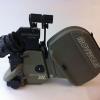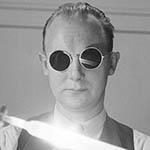
HockeyFan12
-
Posts
887 -
Joined
-
Last visited
Reputation Activity
-
 HockeyFan12 got a reaction from odie in DIY Film Look
HockeyFan12 got a reaction from odie in DIY Film Look
I think it was Fotokem or one of their competitors I think. We saved money by going with a cheaper session (first light rather than best light) and a cheaper delivery format is what I was referring to, lower quality processing and scan. We were basically grading proxies. They wanted $50k extra for a proper scan, which would have been worth it, but it wasn't in the budget and the look of the film suffered for it, though I think we did well with what we had.
The increase in budget for shooting film rather than video was between $100-$200k. I believe the budget for the feature was just under $1 million. I don't know more, I wasn't a producer on it, just worked in camera department.
That does seem like a very good price. But even at $200 for a roll of 16mm film and $200 for development and scan (lower than I've ever seen available, but consistent with what you suggest) that's $400 for ten minutes of footage (inevitably the ends don't get used, or it would be 11 minutes). At a very conservative shooting ratio of 15:1, a 100 minute feature would cost $60,000 extra at those very low rates (which I still have yet to find).
I agree, I have seen small features shot competently for under $500k and so $560k isn't that much more. But the extra costs in terms of support gear, monitoring, and lighting (500 ISO film is about as clean as 3200 ISO digital, you have a ton of over but your under is just dreadful) push things up much higher. I just can't figure out the math. Even if everyone is working for free, I can't imagine a budget under $200k for a 16mm feature.
I know the story about Primer, but that's sort of the extreme example of a 1:1 shooting ratio and shooting in someone's garage. 99% of stories won't work with those limitations and the budget was much higher than that once it was polished up for a salable deliverable.
What features have you shot on 16mm for under $5k? Were they small stories like that or were you able to scale up efficiently beyond that? Did you pay the crew? What gear did G&E gear and how big was the crew? I still can't do the math.
I used to shoot a fair amount of 16mm (for student films and stuff, never professionally), and even back in those days when film was cheap it was still hundreds of dollars extra for a short exercise versus shooting digitally.
Nevertheless, for the money, film is still a great deal and I like your idea of using a digital b camera sparingly. I still plan to shoot my next short on film, but I'm budgeting a few thousand dollars extra just for a 10-minute short and planning to shoot with a tiny tiny ratio.
-
 HockeyFan12 got a reaction from Katrikura in Freedom (and respect)
HockeyFan12 got a reaction from Katrikura in Freedom (and respect)
I've often disagreed with you, but I agree with you here. Your argument is in the spirit of the ongoing "use cheap gear," thread. You should use the medium in an ontologically sound way. Video is fast and ephemeral. Film is slow and physical. Good videos use the difference to their advantage and don't apologize.
In recent history but before video's ubiquity, Zodiac used video very well. Not by apologizing for a smaller sensor or whatever else, but by allowing Fincher to shoot 100s of takes and comp together just the ones that suited that particular film. After the more fringe artists you cite but before the Alexa's prominence, a few other other artists used video unapologetically well: Channel 101 (look at the illustrious alumni from that group of great storytellers)–they also influenced Awesome Show and the SNL Digital Shorts; Dogme 95; Chronicle (very good genre film); and even the toweringly innovative cult classic Werewolf: The Devil's Hound, which used tons of coverage to more than make up for a lack of resources elsewhere. Video is cheap, cameras small. They owned it. A+
Video is not film.
It's not worse.
It's not better.
It is different.
Let it be different. Embrace it. If it's your medium, use it. If it's not, shoot film, which I love the hell out of. To some extent I think film schools are harmful in our era. They teach you the old way, which was great... but now we're in a faster moving age. Even Vine videos are a far more worthwhile medium than most gave them credit for being. A lot of good filmmaking in a given six seconds.
And horses for courses. I can see why JJ Abrams shot film on Star Wars. It made sense. It's nostalgic. I can see why a lot of art films are shot on 16mm. It's physical. As a viewer, I mostly far prefer it. But if digital is what inspired you to get into production, don't apologize. Shoot the hell out of it. It's its own thing. Your voice is your own. Shoot video as video, not as an apology for film, and you've taken a step 95% of A list DPs refuse to. It clips. It wobbles. Love the wobble. Love the clip. Love the pause cut. Love the meme. Love the vloggers. Love snapchat. Love vine. Love what you do, whatever you're doing.
-
 HockeyFan12 got a reaction from Neumann Films in Freedom (and respect)
HockeyFan12 got a reaction from Neumann Films in Freedom (and respect)
I've often disagreed with you, but I agree with you here. Your argument is in the spirit of the ongoing "use cheap gear," thread. You should use the medium in an ontologically sound way. Video is fast and ephemeral. Film is slow and physical. Good videos use the difference to their advantage and don't apologize.
In recent history but before video's ubiquity, Zodiac used video very well. Not by apologizing for a smaller sensor or whatever else, but by allowing Fincher to shoot 100s of takes and comp together just the ones that suited that particular film. After the more fringe artists you cite but before the Alexa's prominence, a few other other artists used video unapologetically well: Channel 101 (look at the illustrious alumni from that group of great storytellers)–they also influenced Awesome Show and the SNL Digital Shorts; Dogme 95; Chronicle (very good genre film); and even the toweringly innovative cult classic Werewolf: The Devil's Hound, which used tons of coverage to more than make up for a lack of resources elsewhere. Video is cheap, cameras small. They owned it. A+
Video is not film.
It's not worse.
It's not better.
It is different.
Let it be different. Embrace it. If it's your medium, use it. If it's not, shoot film, which I love the hell out of. To some extent I think film schools are harmful in our era. They teach you the old way, which was great... but now we're in a faster moving age. Even Vine videos are a far more worthwhile medium than most gave them credit for being. A lot of good filmmaking in a given six seconds.
And horses for courses. I can see why JJ Abrams shot film on Star Wars. It made sense. It's nostalgic. I can see why a lot of art films are shot on 16mm. It's physical. As a viewer, I mostly far prefer it. But if digital is what inspired you to get into production, don't apologize. Shoot the hell out of it. It's its own thing. Your voice is your own. Shoot video as video, not as an apology for film, and you've taken a step 95% of A list DPs refuse to. It clips. It wobbles. Love the wobble. Love the clip. Love the pause cut. Love the meme. Love the vloggers. Love snapchat. Love vine. Love what you do, whatever you're doing.
-
 HockeyFan12 got a reaction from Trek of Joy in Pro camcorders? They're pointless creatively.
HockeyFan12 got a reaction from Trek of Joy in Pro camcorders? They're pointless creatively.
Again, I agree to disagree. I've never even seen stereo audio captured on set (always a 416 or Schoeps or something with lavs mixed for stereo and 5.1 after), but I understand that it's useful for some stuff. My experience is in narrative but for ambient recordings I guess binaural is valuable. I listen to a lot of binaural recordings for music and they're great and I wish more narrative film were mixed like that, actually.
I also strongly disagree about the value of ETTR except on a camera-by-camera and case-by-case basis. I think it benefits the Red, for instance, even when possible using color filters and exposing each channel to the right, and fixing both white balance and exposure in post, assuming you want a "slick" commercial look. Whereas Rob Zombie's DP is a friend of a friend and he exposes the Red at 3200 ISO intentionally to intentionally muddy it up, as he finds that look preferable to a post grain pass for "gritty" footage. And I just find the color vs saturation values and even the hue vs lum shifts (I know I'm talking in Resolve terminology and not camera terminology but I stopped following camera tech closely after film was phased out) with most log colorspaces in particular to be inconsistent enough that (excepting maybe the Alexa) you're better off rating normally, or at the very least consistently, whereas ETTR is inconsistent by nature. Sony's F55 LUT threw me for a loop here in particular. And with inexpensive cameras that shoot 8 bit, ETTR is the surest way to generate banding even in cameras that normally don't suffer from it. That said, it's a case-by-case basis thing, but the cases where I would consider exposing with ETTR are vanishingly rare, especially because it adds such a huge headache in post having your vfx artists work with inconsistently exposed plates and your colorist do so many transforms, but I can see overexposing a stop or two consistently when possible, much as I would rate film 1/3 stop slower than it is, or using ETTR with particularly difficult exposures and fixing it in post rather than bracketing and comping or something.
But while I disagree strongly on both of those points, I strongly agree that it's valuable having and sharing different viewpoints. Readers will see whose goals mirror their own, and structure their needs around those who have similar goals and who have found effective ways to deal with them. So I think your post is really valuable, I'm just offering a counterpoint, from someone with a different perspective, one that's more rooted in narrative I assume, for better or worse. I think I have more concern for "good enough" than for "good" so for me ETTR isn't worth the hassle, but for others it definitely will be. (I'm also extremely lazy, and that's a huge factor in my workflows, often the biggest one.)
-
 HockeyFan12 got a reaction from Jonesy Jones in Is Sustainable Independent Filmmaking Possible?
HockeyFan12 got a reaction from Jonesy Jones in Is Sustainable Independent Filmmaking Possible?
I think it's very possible but it's difficult. I think Rocket Jump has the closest thing to a good model that there is. They are absolutely cleaning up. But at the begging, when you're small, it's going to be very hard to monetize.
If you can move from day job with freelance supplementing it to freelance with creative work supplementing it to creative work paying the bills to creative work making you rich... then you just lived the American dream. If you have a vision, go for it.
I have no advice except look to Rocket Jump and only do it if you have a vision and you're willing to fail but so desperate to succeed you don't worry about setbacks and failures. Look to Patreon and YouTube channels, too.
And let me know what you find out!
And start small. Gall's law is truth!
-

-
 HockeyFan12 reacted to PeterGregg in Canon - the REAL technical and political reasons behind the lack of decent video
HockeyFan12 reacted to PeterGregg in Canon - the REAL technical and political reasons behind the lack of decent video
I agree with many of your statements. One of the statements that you made that I don't agree with is not from this article. First, I am not talking in an adversarial way, so don't raise your shields You made a statement that Canon listens to their customers or photographers or something to that effect. I find from the D30/D60 on forward that isn't true at all. i chuckle when I read Denis Reggie or Jeff Ascough say to me that Canon is listening to them. In my opinion Canon listens to their internal minds, their own game plan, and in a very small very unique window of opportunity, I saw Canon very VERY eager to see what Nikon had up their sleeve at the announcement of the original Nikon D3 camera. At that time, the Canon people were scared sh#tless on what Nikon was launching - I saw it with my own eyes. Never saw that happen again. Leads me to the conclusion that we can add that Canon listens to ONE competitor's actions and products, and that is Nikon. Not Sony or Panasonic, and NOT their customers.
The pattern for Nikon these past few years has been that Nikon has become a sleeping cow. And Canon advancement has tracked Nikon's performance to a the letter. They have been sleepy and lazy because the competition they watch has slumbered off. It is history repeating itself. Pure video people are not going to understand this point of view (with exceptions). But i feel things are going to change. I think Nikon is going to spring out with DPF cameras in a sudden surprise move and start the Nikon Canon machine marching forward again. This isn't pie in the sky there is evidence. Canon will react to money (sales) and Nikon. That is it - end of story. Nikon is asleep - and therefore so is Canon.
Canon will advance with 4K in their cameras when it doesn't matter anymore. probably in about 3 year you will see 4K trickle down to the little cameras and the little people. The only thing to change this track would be Nikon jerking Canon's chain with a Dual Pixel Focus type camera somewhere in their product chain. My guess will be the D810 series with 4K and other goodies this year. Or another camera higher or similar in price next year. Then you will see Canon react. Canon doesn't give a crap about anything else, they have the sales and they have "their" competitor in a choke hold. Sony, Panasonic and Olympus are not competitors - to Canon. When I see comments like Sony is sweeping the market with their products, how many see Canon even blinking lol? Nikon, on the other hand is what moves Canon, can't say it any plainer than that. If Canon sales were going down the toilet, they would react to that too. Neither has budged, and Canon continues to report good sales to their board.
The only buy I can see for active use is the 1DX II. It too leaves a lot to be desired, but there is no other camera I see that can be a workhorse to deliver is a well rounded way. It lacks IS, movie controls, lightness and small size. But it delivers an amazing army of people behind it to keep you up and running (another thing movie people don't put enough sock in - try and get a Panasonic or Sony fixed, yes I know about the new NY and LA centers lol. Chocolate bars for the kids basically. Go to a world event and Canon and Nikon have 18 wheelers full of bodies and lenses and techs to keep everyone up and running, this is more major than most people admit or recognize. Panasonic, Sony and company are "just" starting to make any noise in this area.
I read in this article something that caught my eye. Are you saying that the 1080 feed thru the HDMI is better than most would expect? i would like to know that, it is is true or not. Recording to a $400 Atomos to ProRes on an SSD at a great 1080 and getting pro level results would be a really appealing thing to read!
Also, got the new 2017 iMac i7 580 8GB GPU 40GB Ram yesterday. A 1 minute 5D4 MJPEG 4GB file transcoded to ProRes LT is 35 seconds. Straight from that file, color corrected and to H264 in 36 seconds (no pre-rendering). Color corrected and add a few plug-ins out in 55 seconds. MJPG jail has been cracked. Can work straight from the files, or transcode out to ProRes.
Please say more about the 1DX2 1080 HDMI output and quality.
Peter
-
 HockeyFan12 got a reaction from sam in 1080 vs. 4K: What is REALLY necessary?
HockeyFan12 got a reaction from sam in 1080 vs. 4K: What is REALLY necessary?
Damn it I was hours away from putting up on eBay my P50ST60. Now I think I'll just move it into the other room instead.
-
 HockeyFan12 got a reaction from jonpais in 1080 vs. 4K: What is REALLY necessary?
HockeyFan12 got a reaction from jonpais in 1080 vs. 4K: What is REALLY necessary?
1) The 5k iMac is a great machine. Perfect for 4k editorial. I still don't see the advantage of 4k tvs unless you stand three feet from them (not for me), have better than 20/15 vision, or spend so much money that you're also getting the benefits of other technologies too (4k OLED? yes please... but if not, 1080p kuro plasma). Past a certain size (maybe 100" or so, mostly for projectors) they will have an appreciable advantage in terms of resolution, but below that not really unless you stand close. For monitors and smart phones (very close to the face) then the retina advantage is huge, though, imo. For web deliverables 4k makes sense to me if you can handle it in post.
2) Depends on your workflow. I transcode everything to ProRes or DPX so for me it would be a huge problem for me. You can always switch to 1080p for less important content, though, or if you're editing in Premiere just use the native codec.
-
 HockeyFan12 got a reaction from TheRenaissanceMan in 1080 vs. 4K: What is REALLY necessary?
HockeyFan12 got a reaction from TheRenaissanceMan in 1080 vs. 4K: What is REALLY necessary?
I agree that it's choice, but everyone's choices are informed by different priorities. While it might mostly be consumers blindly choosing the name brand who are buying Canon, it might also be that 4k isn't a priority for most consumers (and pros).
The Alexa, too, is still essentially a 2k camera. It offers a LOT in exchange for this trade off.
IMO, certain Canon models do too. Mostly in terms of ergonomics, color, and DPAF.
Ultimately, I think whatever tool makes you enjoy the process most will be the one that results in the best result, and the result will sort of be tailored to the process anyway. So if art is subjective and mirrors you, then whatever equipment you prefer is the equipment you need to use to do you at that given moment. (Try something new and challenge yourself from time to time, though. Shoot 16mm!! You'll only know yourself better after trying.)
Of course, on set, a 5D Mark II might be a lot of fun. It's tiny and easy, and the viewfinder image looks ok, but in post you have a shitty image to work with grading is gonna suck. Or a DP might love the Red Helium and the editor hates it, or the DP might hate the Alexa or C300 and the editor loves it. So when you're only the DP or only the editor you're gonna have really different priorities than your fellow creatives... and you're gonna see weird preferences and messy workflows and in-fighting and... well... a less fun process.
(The Alexa is kind of great on set and in post... ditto the C300 Mk I. They both did well commercially... Just sayin'.)
For most of the people here, this is a hobby. We're probably shooting and cutting and grading our own footage. So if we want to keep doing that, we'd better make it fun.
For the pros among us, they want the easiest job possible while still enjoying the work and delivering a good product. Fairly similar priorities. You've gotta love it to do it.
So I'd say let the Canon hate go and focus on the Panasonic/Sony/BM love. For the portrait shooter dead set on a full frame stills camera and the 85mm f1.2... just let them have their 6D Mark II, they won't even switch the knob to video. They'll have a blast. I know it drives clicks trashing there 6D, but you know why Canon and Arri are doing well in the market. And why the 1DC failed despite it being a great camera.
Fwiw, I can imagine scenarios in which I'd absolutely need 4k. I like Canon, but I still wish their cameras shot 4k prores.
-
 HockeyFan12 got a reaction from kaylee in Do you guys know anything about 3D scanning/printing?
HockeyFan12 got a reaction from kaylee in Do you guys know anything about 3D scanning/printing?
I have an acquaintance who works for one of the larger 3d scanning companies. They use reality capture for software (widely available) and about 100 consumer-level dSLRs in an evenly lit space designed to reduce specularity on the subject. You could set this up too but the 100 dSLRs gets expensive.
There are consumer-level 3D scanners but they're too low res for what you want to do. I would give a call to some of the higher end 3d scanning houses.
-
 HockeyFan12 got a reaction from Trek of Joy in 1080 vs. 4K: What is REALLY necessary?
HockeyFan12 got a reaction from Trek of Joy in 1080 vs. 4K: What is REALLY necessary?
Why is it then that none of the major networks (tv and cable) broadcast in 4k? And the majority of DCPs are 2k, even when the source material is 4k and above?
Sure there are 4k tvs everywhere (as there were 3d ones everywhere a few years ago), but in terms of content creators and distributors, it's really only Netflix and YouTube Red that care about 4k. For everyone else it's a buzzword. Sure there are 4k tvs, it's planned obsolesce and marketing. But how much 4k content are people watching on those tvs in 4k is a good question...
Netflix's 4k streams look imo worse than a good blu ray. More high frequency detail but worse tonality, with more mosquito noise and compression. YouTube 4k looks worse.
For network and cable tv and for normal wide theatrical release, 4k doesn't matter. For IMAX it matters, but only maybe 20-30 features get IMAX releases a year. For YouTube and Netflix it matters, but not for image quality so much as marketing (again, a good 1080p blu ray looks better 90% of the time).
Almost anywhere else? Not really a factor. I can see 4k mattering more for Vimeo than for theatrical release, since laptops have high res screens and you hold them close to your eyes. But most staff pick are still 1080p and resolution doesn't seem to drive how they're chosen... so I'm still confused by why you place so much value on a fairly insignificant feature.
I do understand the need for 4k. For the occasional vfx background plate or stock footage that might get punched in on, absolutely. On a GoPro you need all the resolution you can get for stabilization and de-fisheying. 4k on GoPros is great. I just don't understand the wider need for 4k on production cameras outside IMAX features, and YouTube Red and Netflix shows, where I would still argue it's mostly a buzzword. And that's such a narrow target where next to nothing is sourced on consumer-grade cameras anyway (Netflix's cheapest acceptable 4k camera is the BM 4.6k). So the purpose of 4k on consumer cameras to me is and always has been marketing.
I dunno. I don't see the appeal. Diminishing returns in image quality for a massive increase in time spent in post.
-
 HockeyFan12 got a reaction from Mattias Burling in 1080 vs. 4K: What is REALLY necessary?
HockeyFan12 got a reaction from Mattias Burling in 1080 vs. 4K: What is REALLY necessary?
I agree that it's choice, but everyone's choices are informed by different priorities. While it might mostly be consumers blindly choosing the name brand who are buying Canon, it might also be that 4k isn't a priority for most consumers (and pros).
The Alexa, too, is still essentially a 2k camera. It offers a LOT in exchange for this trade off.
IMO, certain Canon models do too. Mostly in terms of ergonomics, color, and DPAF.
Ultimately, I think whatever tool makes you enjoy the process most will be the one that results in the best result, and the result will sort of be tailored to the process anyway. So if art is subjective and mirrors you, then whatever equipment you prefer is the equipment you need to use to do you at that given moment. (Try something new and challenge yourself from time to time, though. Shoot 16mm!! You'll only know yourself better after trying.)
Of course, on set, a 5D Mark II might be a lot of fun. It's tiny and easy, and the viewfinder image looks ok, but in post you have a shitty image to work with grading is gonna suck. Or a DP might love the Red Helium and the editor hates it, or the DP might hate the Alexa or C300 and the editor loves it. So when you're only the DP or only the editor you're gonna have really different priorities than your fellow creatives... and you're gonna see weird preferences and messy workflows and in-fighting and... well... a less fun process.
(The Alexa is kind of great on set and in post... ditto the C300 Mk I. They both did well commercially... Just sayin'.)
For most of the people here, this is a hobby. We're probably shooting and cutting and grading our own footage. So if we want to keep doing that, we'd better make it fun.
For the pros among us, they want the easiest job possible while still enjoying the work and delivering a good product. Fairly similar priorities. You've gotta love it to do it.
So I'd say let the Canon hate go and focus on the Panasonic/Sony/BM love. For the portrait shooter dead set on a full frame stills camera and the 85mm f1.2... just let them have their 6D Mark II, they won't even switch the knob to video. They'll have a blast. I know it drives clicks trashing there 6D, but you know why Canon and Arri are doing well in the market. And why the 1DC failed despite it being a great camera.
Fwiw, I can imagine scenarios in which I'd absolutely need 4k. I like Canon, but I still wish their cameras shot 4k prores.
-
 HockeyFan12 reacted to ssrdd in Pro camcorders? They're pointless creatively.
HockeyFan12 reacted to ssrdd in Pro camcorders? They're pointless creatively.
Sony fs5 is a bummber from the beginnng from the day one why cry now
-
 HockeyFan12 got a reaction from Dave Maze in 1DC Discontinued
HockeyFan12 got a reaction from Dave Maze in 1DC Discontinued
Yeah I wouldn't get worked up about it. 7Ds on technocranes were common in tv for quite a while. Granted Deakins I'm guessing would have turned down the 7D but this is more about size and convenience than it is about image quality.
But yes, it proves the 1DC is "good enough" for a sweeping wide shot being intercut with the Alexa. Which is pretty good!
-
 HockeyFan12 got a reaction from Christina Ava in Cheap wide glass for 5D mark IV? looking for recommendations
HockeyFan12 got a reaction from Christina Ava in Cheap wide glass for 5D mark IV? looking for recommendations
Seeing as both are APS-C and designed for a roughly 1.6x crop... and the 5D's video is a 1.6x crop... I don't think the speed booster would do that much good (maybe you could squeeze 10% more FOV out of the Sigma).
I would be careful with the Canon. The rear element might bump up against the mirror and you will need to remove the EF-S tab just to get it to mount. Furthermore, its IS is not particularly good, not as good as in the current kit lenses by far. It's a nice lens though, despite that.
-
 HockeyFan12 got a reaction from Christina Ava in Cheap wide glass for 5D mark IV? looking for recommendations
HockeyFan12 got a reaction from Christina Ava in Cheap wide glass for 5D mark IV? looking for recommendations
Another vote for the 18-35mm (I'm selling mine if you're interested.... but I'm in the US). AMAZING lens. As sharp as many $40k cine zooms, faster than cine zooms, and par focal. Diffraction limited wide open in the center. Good rendering, too, feels apochromatic. Ridiculously good. But it's not that wide. It's as wide as I need to go and as wide as "classical" lenses go but for that John Woo/Terry Gilliam/Michael Bay look you gotta go wider and tackier.... This lens is a classic, though. A+.
The 14mm Samyang has too much distortion imo. It's okay but kind of gross for video. A lot less bad cropped than it is at FF, though. Also a lot less wide. C+
11-16mm Tokina is fine. Not exciting rendering and high flare and some CA but I find it to be quite good. Sharp. An okay look. Very low distortion. 11-20mm is a little better. Neither have a lot of character. B
The 18-55mm kit lens is not horrible but you'd need to remove the EF-S tab. It's not that good... but it's really not that bad and for its price used it's a big winner. And it has very good IS. Too bad about the EF-S tab. It's a decent lens. I (incomplete)
-
 HockeyFan12 got a reaction from Grimor in DIY Film Look
HockeyFan12 got a reaction from Grimor in DIY Film Look
The last feature I was on that shot 35mm had a very low shooting ratio, got a killer deal from Kodak, and used horrible low quality scans. I think the added cost of shooting film (despite a virtually free camera) was nearly $200k. This was the ABSOLUTE cheapest deal around at the time, and prices have gone up. I just can't figure out how you're shooting that cheaply. They also shot with a digital b cam for a pretty substantial part of the shoot.
I find lab fees and scans significantly more expensive than film stock if you want high quality 2k scans. What labs are you using that will develop and 2k scan 400 feet of 16mm for $200? I've yet to find any but every time I budgeted it out shooting on 16mm adds at least a few thousand dollars to the budget for a 10-minute short, and maybe much more. I agree having a digital b cam is smart. That said, for a short film, a few thousand dollars is not much, but difficult to stomach when it's all out of pocket and with no hope of a financial return.
-
 HockeyFan12 got a reaction from BTM_Pix in 18-135mm Nano USM and PZ-E1 question
HockeyFan12 got a reaction from BTM_Pix in 18-135mm Nano USM and PZ-E1 question
It does not. The contacts do seem to pass data.
-
 HockeyFan12 got a reaction from webrunner5 in Pro camcorders? They're pointless creatively.
HockeyFan12 got a reaction from webrunner5 in Pro camcorders? They're pointless creatively.
But your average set day costs in excess of six figures. That's nice when someone else is paying for it (in that case, bring the Alexa). When you don't have those luxuries, it's better to work around them than to buy them out of pocket. I wouldn't have that much fun or feel that much freedom if I knew my shoot were costing me a year's pay. And without those luxuries (which are far more expensive to hire than the cost difference between an Alexa and a t2i), a smaller camera ends up delivering a better result 9/10 times.
But you're right, there are incredible advantages to being a pro DP and it's a great job and something to be very proud to be. I was kidding about the "being a pro sucks" rant. Of course it's great! It's just that it has its trade offs, and for us amateurs, we'd do better using amateur gear. 1) because it's cheaper to buy 2) because it's much cheaper to use. And the image quality is, as you say, only about 10% better. Most pro DPs aren't lugging an Alexa around to shoot pick ups, either. Most aspiring pros would do better to follow their example.
I say this as someone who's tried running around with an Alexa a few times before lol. It's no fun!
-
 HockeyFan12 got a reaction from Hans Punk in how to simulate the original "shake" of the old movies shot on film?
HockeyFan12 got a reaction from Hans Punk in how to simulate the original "shake" of the old movies shot on film?
We're thinking about a lot of the same things! Fwiw I tried the plug ins you mentioned before and found neither worked well, which is why I didn't comment on them before. Imo the Red Giant one really misses the mark, even though they have a lot of other good stuff. But the After Effects wiggle expression and tracking tricks work okay for me. I also do a lot of per-channel regraining (separating channels, overlaying grain on each, recombining them) to get color grain and make sure the blue/yellow noise is more prominent, but it still doesn't quite have the integrated look that film has. Curious what your best results are from for "film look." I also like the vibrance plug in.
I agree about miniDV.
My friend has the new 120fps iPad and says it makes a huge difference with scrolling. Likewise VR is 90-120fps. I think we're gonna see that being the standard pretty soon, but in VR not in film, or at least mostly in VR.
-
 HockeyFan12 got a reaction from Kubrickian in 18-135mm Nano USM and PZ-E1 question
HockeyFan12 got a reaction from Kubrickian in 18-135mm Nano USM and PZ-E1 question
It's appropriate that a Kubrick fan would want this. I really suspect that this product isn't going to be very good, but there are times when I want a smooth zoom, too.
Another option is doing it the old school way and putting a lens gear on your zoom ring and using a wireless FF. A friend tried this with my 70-200mm and my DJI focus.
Mixed results. :/ Felt slightly granular and rough but only slight... it kind of worked. Definitely felt like a motorized zoom. Actually pretty darned good and obviously no aperture racking there.
For super great results, renting one of the Canon or Fujinon zooms might be the right way to go. But I'm not after the right way, just the cheap way and the easy way and the portable way.
-
 HockeyFan12 got a reaction from BTM_Pix in 18-135mm Nano USM and PZ-E1 question
HockeyFan12 got a reaction from BTM_Pix in 18-135mm Nano USM and PZ-E1 question
Well, it isn't quite what I was looking for. I don't think either of you are the target audience. I wonder if anyone really is? It feels consumer-oriented.
I've only tried the lens indoors with poor light so maybe it gets better outside. But it seems to flicker exactly like in the videos above (less than some lenses, more than you want) unless you zoom in wide open, in which case the aperture racks just over a stop between 18mm and 135mm.
It doesn't seem like that much, though. This is pretty acceptable.
At a consistent f5.6, it flickers noticeably but subtly. Both On my SL1 and C100.
Even in auto ISO. I think? Auto ISO pulses for some reason or another. And the C100 doesn't have it.
Even if the flicker weren't a problem, the ramp acceleration takes a long time to begin and is difficult to control in both fast and slow speeds. Inadequate to follow action or fast-moving events. It's not all the smooth either. The rocker feels great but doesn't seem analogue but instead very granular. The rocker might have a total of five steps on it. It might have just three (zoom in, don't zoom, zoom out). Slow zoom looks cool, though.
Programming a zoom into a wireless FF seems the better option. By far.
For the 80D crowd it's nice, though. Great balance, good ergonomics. Weird rocker placement makes sense for C series and dSLRs given the grip placement. Image quality seems okay. Great zoom range and light weight. And despite the adapter's flaws, it approximates the job closely enough to be functional and fun to use. Non-picky consumers will like it. Creative people willing to fix problems in post or who need to shoot a fake newscast or something will have fun with it. I might sell my hvx still! But this thing is a lot of $$$ for a toy/consumer-grade (not that controllable so not professional-level, but intuitive and workable enough to be fun, at least, so not garbage) product.
To me it just seems like an immature consumer product. Not particularly good at anything. But not an embarrassment, either, and a cute novelty. But... not very good.
What's really crazy... REALLY crazy is that it seems the contacts are only for power and they don't do anything to zoom or focus. They're also exposed all the time unless you attach the adapter and ate kind of unsightly. Strange for such a ubiquitous kit lens to behave that way... The zoom mechanism actually seems to be similar to a wireless FF where a lens gear on a motor catches the gear on the mechanical helical zoom/focus mechanism. It's not internally controlled at all, it's controlled by a gear in the zoom mechanism. The finely notched grip on the zoom ring on the lens catches a fine gear in the PZ-E1, and so that physical might account for the slow acceleration and slightly inconsistent zoom speed and feel. Really weird!
So it's not very good. But it sits well on the C100 in terms of size and feel. And if you need that slow Kubrick zoom for the absolute bare bones price, this will be able to communicate that intent. Horribly awkwardly and inartistically and not even consistently, sure, but it does function. That might sound like a dismissal, and I think for most people who want a real zoom rocker a camcorder is the better choice, but it's why I'm keeping it despite not recommending it to anyone.
-
 HockeyFan12 got a reaction from TheRenaissanceMan in £150 Arriflex lenses on the GH5
HockeyFan12 got a reaction from TheRenaissanceMan in £150 Arriflex lenses on the GH5
These look awesome. I almost bought a large kit of these alongside a 16mm film camera but my friend has an SRII so I just couldn't justify it.
Still don't need them so I probably made the right choice passing on them, but.... wow that bokeh looks cool. I know DPs who shoot Cooke S2/S3s when they can't use anamorphic because it has some texture to it that looks good in motion. Similar rendering to this. Look at the prices of Super Baltars and Cookes. A coveted look.
-
 HockeyFan12 got a reaction from Chris Oh in 18-135mm Nano USM and PZ-E1 question
HockeyFan12 got a reaction from Chris Oh in 18-135mm Nano USM and PZ-E1 question
I have no self-control lol. Especially after two beers.
I'll let you know what I think. Neither my C100 nor SL1 have a hint of decent autofocus but I can put them through their paces.















